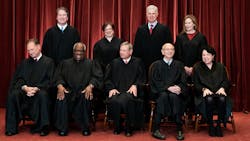U.S. Supreme Court kills Clean Power Plan, limits EPA's role in forcing Utility-scale Emissions reduction nationwide
The Obama-Era Clean Power Plan did not survive the Trump era. But now it is surely dead, along with much of the EPA's regulatory momentum to make era-defining decisions.
The U.S. Supreme Court, voting 6-3 along ideological lines, shot down the Environmental Protection Agency’s right to force states to reduce carbon emissions by shutting down coal-fired generation in favor of renewables. The decision casts doubt on the agency’s ability to force energy transition rules on many of those power generation facilities and utilities.
The majority opinion in West Virginia v. EPA did not say that dirtier power plants were not a danger to public health or the environment, but said the power to regulate them en masse rested with the people’s representatives and not the executive branch.
“Capping carbon dioxide emissions at a level that will force a nationwide transition away from the use of coal to generate electricity may be a sensible solution to the crisis of the day,” reads the end of the majority opinion involving Chief Justice John Roberts and fellow Republican-appointed Justices Alito, Thomas, Gorsuch, Kavanaugh and Barrett.
“But it is not plausible that Congress gave EPA the authority to adopt on its own such a regulatory scheme ...,” the prevailing opinion concluded. “A decision of such magnitude and consequence rests with Congress itself, or an agency acting pursuant to a clear delegation from that representative body.”
The Obama-era Clean Power Plan was announced in 2015, during a period when the U.S. executive branch was pursuing environmental policies in line with the Paris Climate Accord. It set carbon reduction goals for each state’s power generation entities, same as high as 50 percent below 2005 levels by 2030, in the case of North Dakota.
Many states, including that one, lined up to the file suit against the EPA edict, alleging regulatory overstretch. The point was figured moot when the Trump EPA repealed the Clean Power Plan and replaced it with the more fossil-fuel friendly Affordable Clean Energy Act.
Nonetheless, the Supreme Court took up the case and rendered a decision as much about power in the political sense as power in the electricity generation sense. To paraphrase, some goals may be right but not rightly decided.
“When Congress seems slow to solve problems, it may be only natural that those in the Executive Branch might seek to take matters into their own hands,” reads a concurring opinion by Justice Neil Gorsuch. “But the Constitution does not authorize agencies to use pen-and-phone regulations as substitutes for laws passed by the people’s representatives.”
Democratic-appointed Justices Kagan, Sotomayor and retiring Republican appointee Breyer opposed the rejection of the Clean Power Plan.
Most utilities in the U.S., however, are seeking certainty in their generation planning and already have announced net-zero or aggressive carbon-reduction goals for the future.
Justice Kagan noted the same in her dissenting opinion.
“The Trump administration’s repeal of the Plan created a kind of controlled experiment: The Plan’s ‘magnitude’ could be measured by seeing how far short the industry fell of the Plan’s nationwide emissions target,' Kagan wrote. "Except that turned out to be the wrong question, because the industry didn’t fall short of the Plan’s goal; rather, the industry exceeded that target, all on its own. And it did so mainly through the generation-shifting techniques that the Plan called for.”
About the Author
Rod Walton, EnergyTech Managing Editor
Managing Editor
For EnergyTech editorial inquiries, please contact Managing Editor Rod Walton at [email protected].
Rod Walton has spent 17 years covering the energy industry as a newspaper and trade journalist. He formerly was energy writer and business editor at the Tulsa World. Later, he spent six years covering the electricity power sector for Pennwell and Clarion Events. He joined Endeavor and EnergyTech in November 2021.
Walton earned his Bachelors degree in journalism from the University of Oklahoma. His career stops include the Moore American, Bartlesville Examiner-Enterprise, Wagoner Tribune and Tulsa World.
EnergyTech is focused on the mission critical and large-scale energy users and their sustainability and resiliency goals. These include the commercial and industrial sectors, as well as the military, universities, data centers and microgrids. The C&I sectors together account for close to 30 percent of greenhouse gas emissions in the U.S.
He was named Managing Editor for Microgrid Knowledge and EnergyTech starting July 1, 2023
Many large-scale energy users such as Fortune 500 companies, and mission-critical users such as military bases, universities, healthcare facilities, public safety and data centers, shifting their energy priorities to reach net-zero carbon goals within the coming decades. These include plans for renewable energy power purchase agreements, but also on-site resiliency projects such as microgrids, combined heat and power, rooftop solar, energy storage, digitalization and building efficiency upgrades.

